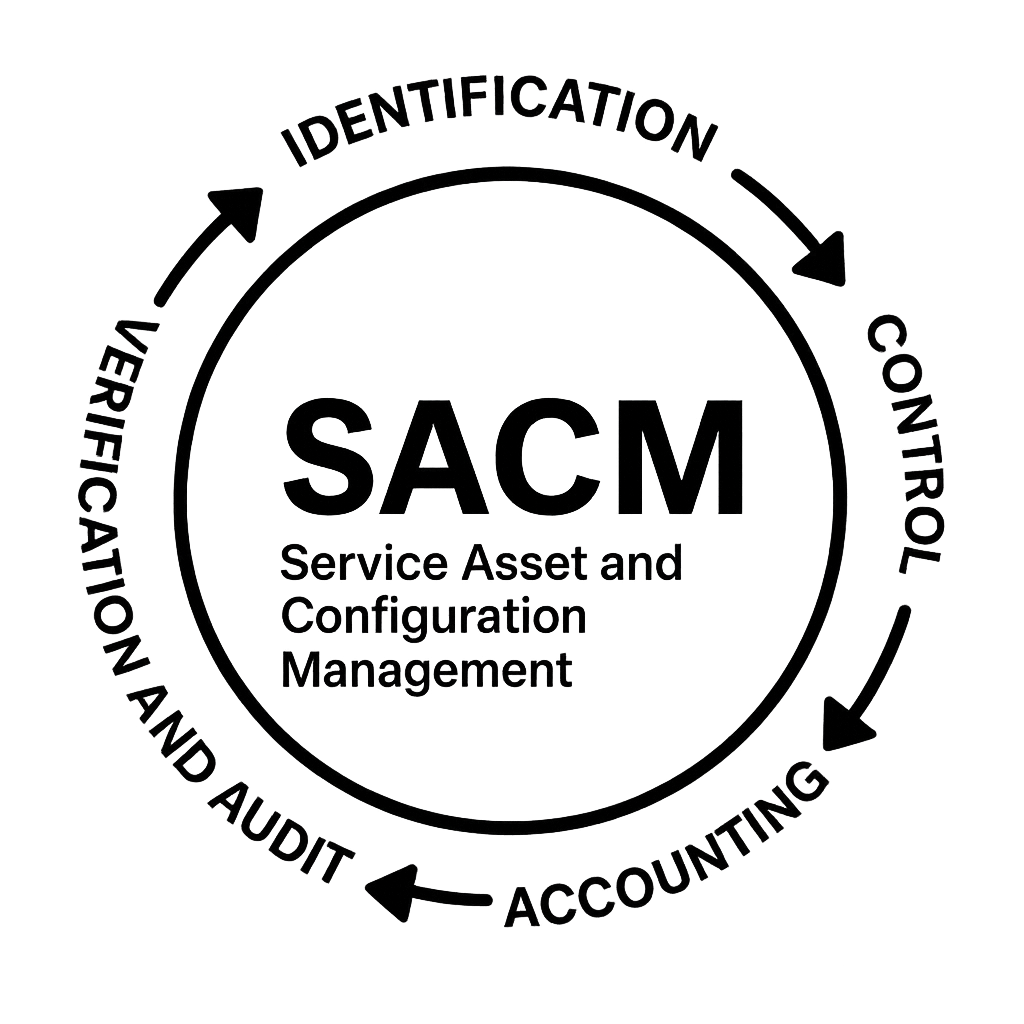Service Asset and Configuration Management:
Integrating Assets with IT Services
 Introduction
Introduction
Modern organizations rely on complex, interconnected IT ecosystems. While ITAM disciplines govern individual categories of assets, SACM provides the connective tissue that integrates these assets into a unified framework. The ITIL framework defines SACM as the process that ensures assets and configuration items are properly managed and that reliable information is available for decision-making (Axelos, 2019). This article explores SACM’s principles, lifecycle, and challenges, demonstrating how it supports not only asset governance but also IT Service Management (ITSM).
Defining Service Asset and Configuration Management
SACM is concerned with both service assets and configuration items (CIs). Service assets include any resource used to deliver a service, such as applications, infrastructure, and people. Configuration items, on the other hand, are the specific components of IT services that must be managed in order to deliver these services effectively (Barone, 2020).
At the heart of SACM is the Configuration Management Database (CMDB), which serves as a centralized repository of information about assets, configurations, and their relationships. For example, a CMDB may contain records linking a physical server (managed under HAM), the licensed operating system installed on it (managed under SAM), the database service it supports, and the customer-facing application that depends on the database.
The SACM Lifecycle
SACM operates through a lifecycle designed to ensure that assets and CIs remain accurate, traceable, and meaningful to IT operations.
The lifecycle begins with identification, where assets and CIs are defined, categorized, and recorded in the CMDB. This step involves establishing naming conventions, attributes, and relationships. For instance, a new virtual server may be logged as a CI, with links established to its host hardware, operating system, and associated services.
Following identification is the control phase, which ensures that only authorized assets and configurations are introduced or modified. This is often achieved through integration with change management processes. A proposed network upgrade, for example, would not proceed until SACM processes validate its impact and ensure CMDB accuracy.
The status accounting phase provides visibility into the current and historical state of assets and CIs. IT teams can query the CMDB to determine when a server was last patched, which incidents affected it, and which services depend on it.
Finally, the verification and audit phase ensures the integrity of the CMDB by reconciling recorded data with actual configurations. Regular audits help prevent drift, where discrepancies between documented and actual environments create risk.
Benefits of Service Asset and Configuration Management
SACM provides several organizational benefits. One of the most significant is improved decision-making. By providing visibility into asset relationships, SACM enables IT leaders to assess the impact of changes, prioritize incidents, and plan capacity.
Another key benefit is risk reduction. With accurate dependency mapping, organizations can avoid service disruptions caused by unauthorized changes or unrecognized interdependencies. For example, before decommissioning a server, SACM ensures that no critical applications still rely on it.
SACM also strengthens regulatory compliance. By maintaining auditable records of asset states and changes, organizations can demonstrate accountability during compliance audits, whether for financial reporting, data privacy, or industry-specific regulations (Gartner, 2021).
Furthermore, SACM enhances operational efficiency. Helpdesk teams resolving incidents benefit from CMDB insights, as they can quickly identify affected systems, users, and dependencies, accelerating resolution times.
Challenges in Implementing SACM
Despite its benefits, SACM is among the most challenging ITIL processes to implement. One of the primary difficulties is CMDB accuracy. Without regular updates and audits, the CMDB can quickly become outdated, undermining its reliability.
Another challenge is the complexity in defining the scope. Organizations often struggle to determine which assets and CIs should be tracked. Overly detailed CMDBs become unmanageable, while insufficiently detailed ones fail to deliver value.
Cultural resistance also hinders SACM adoption. IT teams may view SACM processes as bureaucratic or time-consuming, particularly if integration with daily workflows is weak. Overcoming this challenge requires clear governance policies and tool automation.
Finally, tool integration remains a persistent challenge. SACM tools must integrate with ITSM platforms, discovery tools, and monitoring systems. Without seamless integration, data silos and inconsistencies emerge, weakening SACM’s effectiveness.
SACM and Its Relationship with ITAM and ITSM
SACM is unique within ITAM because it provides relational context. While HAM, SAM, CAM, and IAM manage categories of assets, SACM connects them into service delivery chains. This integration is essential for ITSM processes such as incident, problem, and change management (Axelos, 2019).
For example, when a critical incident occurs in a banking application, SACM data in the CMDB helps IT teams trace dependencies back to the underlying server, database, and network infrastructure. This holistic visibility enables rapid root cause analysis and resolution.
By bridging asset management with service management, SACM ensures that IT resources are not managed in isolation but in alignment with the services they enable.
Conclusion
Service Asset and Configuration Management is a cornerstone of ITIL practices, providing the visibility, control, and relational framework needed to manage complex IT environments. By maintaining accurate records of assets, CIs, and their interdependencies, SACM improves decision-making, reduces risks, ensures compliance, and enhances operational efficiency. While challenges such as CMDB accuracy, scope definition, and cultural resistance persist, effective SACM enables organizations to integrate IT asset management with IT service delivery. Positioned within the ITAM ecosystem, SACM serves as the bridge between asset governance and service excellence.
References
- Axelos. (2019). ITIL Foundation: ITIL 4 Edition. AXELOS Limited.
- Barone, P. (2020). IT Asset Management: A Pocket Survival Guide. Van Haren Publishing.
- Gartner. (2021). Configuration Management Databases and ITSM: Best Practices. Gartner Research.


 Introduction
Introduction